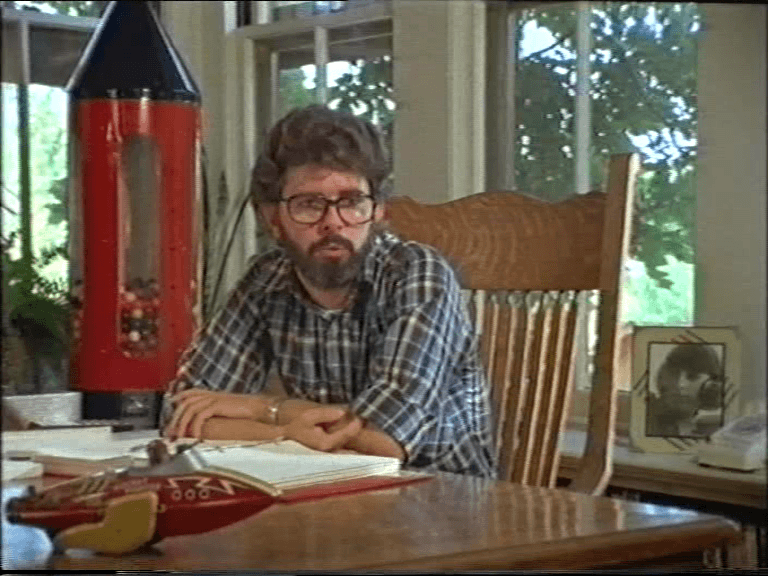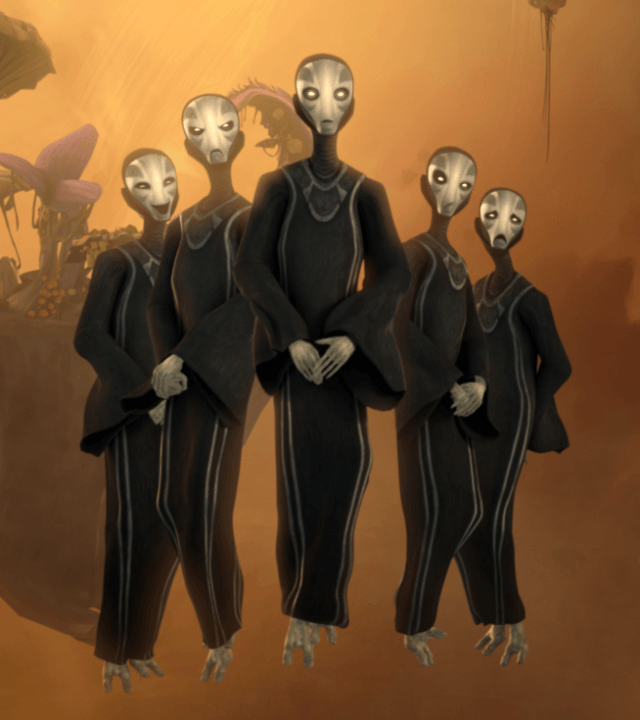NOTE: Small spoiler from reports of the recent 28 minute press screening of Rogue One footage.
In 1973, when George Lucas first attempted to put down the ideas he had for what became Star Wars, he titled his notes and synopsis the “Journal of the Whills.” The Whills were meant to be unseen chroniclers of the story he was writing, giving his work a preexisting mythological quality akin to J. R. R. Tolkien’s Middle-earth.

The following quote from Lucas comes from Star Wars: The Annotated Screenplays describing his thoughts behind the creation of the Journal of the Whills:
“Originally, I was trying to have the story be told by somebody else; there was somebody watching this whole story and recording it, somebody probably wiser than the mortal players in the actual events. I eventually dropped this idea, and the concept behind the Whills turned into the Force. But the Whills became part of this massive amount of notes, quotes, background information that I used for the scripts; the stories were actually taken from the ‘Journal of the Whills’.”
The Journal treatment began with “This is the story of Mace Windy, a revered Jedi-bendu of Ophuchi, as related to us by C. J. Thorpe, padawaan learner to the famed Jedi.”

Lucas only wrote a few pages of this before running out of ideas. He would later resume his writing with a story treatment based heavily on the Akira Kurosawa film The Hidden Fortress as a jumping off point.
The Story Treatment, Rough Draft, and First Draft scripts have no references to the Journal of the Whills. The Second and Third drafts open with an excerpt of a prophecy from the Journal:
… And in the time of greatest
despair there shall come a savior,
and he shall be known as: THE SON
OF THE SUNS.
Journal of the Whills, 3:127
This abandoned idea of a prophetic savior was likely the inspiration for the prophecy of the “Chosen One,” switching the focus from Luke to his father. The title “Son of Suns” was eventually applied to an alien chieftain in an episode of The Clone Wars without reference to a prophecy.
The Fourth Draft script abandoned the prophesy quote, now referencing the Whills in the subtitle “as taken from the Journal of the Whills,” once again making the story of the film a part of the Journal itself. Also, in place of the prophecy, the script has the film open with “A long, long time ago in a galaxy far, far away an incredible adventure took place…” giving the film more of a fairy tale tone.
The novelization of Star Wars, ghostwritten by Alan Dean Foster, also makes a reference to the Whills, beginning with an excerpt taken “From the First Saga: The Journal of the Whills.” The excerpt summarizes a version of Palpatine’s rise from Senator to Emperor, the fall of the Jedi, and the beginnings of the Rebellion.

While the “Public Version” of the final Fourth Draft script still has the “from the Journal of the Whills” subtitle, it of course did not make it into the actual film and there is no other reference to the Whills in the film or its sequels.
There would not be another reference by Lucas to the Whills until the script to Revenge of the Sith. In a deleted scene, the voice of Qui-Gon tells Yoda that the ability to retain ones identity after death was achieved by “a Shaman of the Whills.” Yoda later tells Obi-Wan regarding Qui-Gon that “The secret of the Ancient Order of the Whills, he studied. How to commune with him. I will teach you.”
In this iteration of the idea, the Whills are not simply chroniclers, but users of the Force like the Jedi.
In the book The Making of Revenge of The Sith, Lucas is quoted as saying that the story of the Star Wars saga was told to a “Keeper of the Whills” by R2-D2 a hundred years after Return of the Jedi.
Though the script and the making of book refer to the Whills, none of this information made it into the final film.
In the Sixth Season of The Clone Wars, we saw that Yoda started to learn the ability to retain his identity from Force Priestesses who had been training Qui-Gon before his death.

I assumed that the priestesses had replaced the idea of the Shaman of the Whills, however, there is still a reference to the Shaman on the official site in Qui-Gon’s “Biography Gallery.” I asked Lucasfilm’s Pablo Hidalgo on Twitter if the reference was an oversight that hasn’t been corrected yet. Surprisingly, he responded with “No, that’s taken from the script. Who that Shaman is and how he or she connects to the Priestesses is not yet revealed.” So it appears that the Shaman of the Whills is canon after all!
Outside of non-canon references in the old Expanded Universe, no other references to the Whills were made until the release of the Force Awakens novelization, once again written by Alan Dean Foster. The novel begins with a quote from the Journal of the Whills:
First comes the day
Then comes the night.
After the darkness
Shines through the light.
The difference, they say,
Is only made right
By the resolving of gray
Through refined Jedi sight.
―Journal of the Whills, 7:477
This was the first confirmed canonical reference to the Whills, and it was not the last reference we would be getting.
With the release of the reference book Star Wars: Galactic Atlas in November, we were given our second canon reference to the Whills. In the Jedha section of the atlas, the prominent structure seen in the trailers for Rogue One was identified as the “Temple of the Whills.”

It is noted of the temple that it was considered sacred by the Church of the Force, an underground group who still believed in the Force and the ideals of the Jedi. Max von Sydow’s character, Lor San Tekka, and others in the Jakku settlement destroyed by the First Order were members of this group.
Then, early in December, several people attending Disney’s Star Wars Launch Bay reported a display revealing that Chirrut Imwe (already my favorite Rogue One character) uses a “lightbow” that is the “traditional hand-crafted weapon built by the Guardians of the Whills.”

[Image posted on Twitter by Amy Ratcliffe]
This made me wonder if Chirrut himself is a Guardian or just using one of their weapons? Based on recent reports on sites such as UPROXX and /FILM who were able to see twenty-eight minutes of footage from Rogue One, Chirrut is indeed called a Guardian of the Whills in the film.
The word “lightbow” and the presence of kyber crystals on Jedha also make me wonder if the Guardians use kybers to make their weapons, similar to the Jedi.

Who are the Guardians? Are they “Whills” themselves, or are they simply guarding the work of the Whills? Are the Whills even alive anymore to function as the chroniclers of the saga as they were originally created to be?
We are told in the official Databank entry for Jedha that the moon “is home to one of the first civilizations to explore the nature of the Force.” Intriguingly, this entry used to say “was home” and was recently changed. This makes me think it is a reference to the Whills and that they still exist in some form at the time of Rogue One. But how many of them will survive the film?
Jedha is also said to have once been important to the Jedi Order. We know now that Jedha is a source of kyber crystals used by the Jedi for their lightsabers, and that the Empire is exploiting kyber crystals for the Death Star. We also see an enormous fallen statue of a Jedi on Jedha, suggesting that they had more than a passing presence on the moon.

With this information and the quote from the Journal, we know that the Whills had some connection to the Jedi, but how they are connected remains to be seen. It is clear that Chirrut has some level of Force sensitivity, though he apparently does not have the level of sensitivity that would be required to be a Jedi. Perhaps the Whills were a separate order of Force users who could not use the Force to the same degree of the Jedi but allied with them and chronicled their history.
The Whills aren’t the only early Lucas concepts that have been made canon.
Starkiller, the original last name for Luke right up until the first day of filming, was repurposed as the name of the First Order’s superweapon planet in The Force Awakens.
The name Bendu, from Lucas’s original name for the Jedi, “the Jedi-Bendu,” became canon in Rebels as the name of a Force sensitive being who takes the middle road between the light and dark sides of the Force.
Lucas’s original terms for the light and dark side of the Force, the Ashla and the Bogan, became canon in Rebels. Intriguingly, Ashla was also an alias used by Ahsoka in her eponymous novel.
Kyber crystals, originally the “MacGuffin” plot device before the Death Star plans, were Force enhancing crystals in several drafts. Kybers became canon in The Clone Wars as the crystals used to create lightsabers. Large versions of the crystals were used for ancient Sith superweapons, similar to the way the Empire uses them to create the Death Star with the research of Galen Erso. Galen’s research into the kyber crystals was explored in the Rogue One prequel novel Catalyst and will be integral to Rogue One itself.
As a long time enthusiast of the development of the Saga and its abandoned concepts, I am very glad to see these things coming into canon, especially the Whills, and can’t wait to see how they are further developed and implemented.
———————
Resources: I highly recommend these if you want to learn more about the early drafts of Star Wars:
Star Wars: The Annotated Screenplays by Laurent Bouzereau
The Development of Star Wars by Jan Helander
Starkiller: The Jedi Bendu Script Site (where you can read the full scripts)
Until next time, may the Force be with you.

[…] SOURCE: IGN , Nerdist , Star Wars Report […]
Good essay; informative.
[…] and is reiterated in The Force Awakens by Lor San Tekka. Could these be volumes within the larger Journal of the Whills, which we know speaks of the […]
Excelent article. Thank you very much!